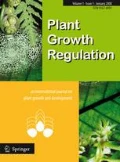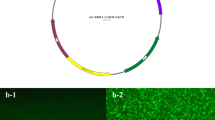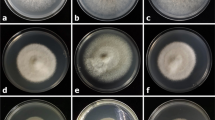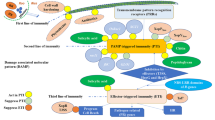Abstract
Huanglongbing (HLB, also commonly known as citrus greening disease) is caused by the bacterium Candidatus Liberibacter asiaticus (CLas) in the US. It is a serious plant disease causing tremendous economic damages and posing an existential threat to the citrus industry worldwide. CLas proliferates inside the phloem, clogs the transportation system, stunts plant growth and renders trees barren. Currently there is no cure or effective treatments for this disease. In this study, qPCR and scanning electron microscopy (SEM) were used to examine orange plants with or without HLB symptoms. We found that symptomatic HLB plants showed high levels of CLas DNA and its prophage in leaves and had heavily clogged phloem tissues. In contrast, the asymptomatic, healthy looking plants had detectable, low levels of CLas and prophage DNA by qPCR but the SEM imaging revealed phloem clear of clogging deposits. Transcription of several CLas phage genes was detected in both healthy and diseased plants, however, higher transcription levels were observed in the healthy plants than in the diseased plants. As part of our efforts to explore the possibility of using a plant-based antibacterial concoction named Agent G to mitigate HLB, NMR and GC/MS were used to assess its organic chemical composition and migration through the phloem tissue. It was found that the major compounds of Agent G were allyl polysulfides and cinnamaldehyde. The phloemic migrate rate in planta was estimated between 1.5 and 3.25 cm/h. Our studies suggest that a combination of qPCR test and SEM imaging may prove to be more informative for gauging growth status of citrus plants and for early HLB detection. We also showcase a feasible approach of treating HLB by delivering antibacterial reagents directly into the phloem tissue where most CLas reside.






Similar content being viewed by others
References
Araújo P, Cesarino I, Carmello-Guerreiro SM, Dornelas MC (2013) Citrus sinensis L. Osbeck orthologs of FRUITFULL and SHATTERPROOF are differentially expressed during fruit development. Plant Growth Regul 70:1–13
Avato P, Bucci R, Tava A, Vitali C, Rosato A, Bialy Z, Jurzysta M (2006) Antimicrobial activity of saponins from Medicago sp.: structure-activity relationship. Phytother Res 20(6):454–457
Balogh B, Canteros BI, Stall RE, Jones JB (2008) Control of citrus canker and citrus bacterial spot with bacteriophages. Plant Dis 92:1048–1052. https://doi.org/10.1094/PDIS-92-7-1048
Bové JM (2006) Huanglongbing: a destructive, newly-emerging, century-old disease of citrus. Invited review. J Plant Pathol 88:7–37
CDC (2018) Initiatives for addressing antimicrobial resistance in the environment: current situation and challenges. US Centers for Disease Control and Protection, https://wellcome.ac.uk/sites/default/files/antimicrobial-resistance-environment-report.pdf
Criado MV, Veliz CG, Roberts IN, Caputo C (2017) Phloem transport of amino acids is differentially altered by phosphorus deficiency according to the nitrogen availability in young barley plants. Plant Growth Regul 82:151–160
Croxton SD, Stansly PA (2014) Metalized polyethylene mulch to repel Asian citrus psyllid, slow spread of huanglongbing and improve growth of new citrus plantings. Pest Manag Sci 70:318–323
Dawson WO, Bar-Joseph M, Garnsey SM, Moreno P (2015) Citrus tristeza virus: making an ally from an enemy. Annu Rev Phytopathol 53:137–155
Dewey JS, Savva CG, White RL, Vitha S, Holzenburg A, Young R (2010) Micron-scale holes terminate the phage infection cycle. Proc Natl Acad Sci USA 107:2219–2223
Dierck R, Leus L, Dhooghe E, Van Huylenbroeck J, De Riek J, Van Der Straeten D, De Keyser E (2018) Branching gene expression during chrysanthemum axillary bud outgrowth regulated by strigolactone and auxin transport. Plant Growth Regul 86:23–36
Doud MM, Wang Y, Hoffman MT, Latza CL, Luo W, Armstrong CM, Gottwald TR, Dai L, Luo F, Duan Y (2017) Solar thermotherapy reduces the titer of Candidatus Liberibacter asiaticus and enhances canopy growth by altering gene expression profiles in HLB-affected citrus plants. Hortic Res 4:17054. https://doi.org/10.1038/hortres.2017.54
Dutt M, Barthe GA, Orbović V, Irey M, Grosser J (2015) Evaluation of transgenic citrus for disease resistance to HLB and canker. Acta Hortic 1065:919–924
Etxeberria E, Gonzalez P, Vincent C, Schumann A (2019) Extended persistence of Candidatus Liberibacter asiaticus (CLas) DNA in Huanglongbing-affected citrus tissue after bacterial death. Physiol Mol Plant Pathol 106:204–207
Fan G, Xia Y, Lin X, Hu HQ, Wang XD, Ruan CQ, Lu LM, Liu B (2016) Evaluation of thermotherapy against huanglongbing (citrus greening) in the greenhouse. J Integr Agric 15:111–119
Farag M, Abdel-Mageed WM, Basudan O, El-Gamal A (2018) Persicaline, a new antioxidant sulphur-containing imidazoline alkaloid from Salvadora persica Roots. Molecules 23:484
Fleites LA, Jain M, Zhang S, Gabriel DW (2014) “Candidatus Liberibacter asiaticus” prophage late genes may limit host range and culturability. Appl Environ Microbiol 80(19):6023–6030
Gottwald TR, da Graca JV, Bassanezi RB (2007) Citrus Huanglongbing: the pathogen and its impact. Plant Health Prog. https://doi.org/10.1094/PHP-2007-0906-01-RV
Grafton-Cardwell EE, Stelinski LL, Stansly PA (2013) Biology and management of Asian citrus psyllid, vector of the huanglongbing pathogens. Annu Rev Entomol 58:413–432
Haggis GH, Phipps-Todd B (1977) Freeze fracture for scanning electron microscopy. J Microsc 111:193–201
Hajeri S, Killiny N, El-Mohtar C, Dawson WO, Gowda S (2014) Citrus tristeza virus-based RNAi in citrus plants induces gene silencing in Diaphorina citri, a phloem-sap sucking insect vector of citrus greening disease (huanglongbing). J Biotechnol 176:42–49
Halbert SE, Manjunath KL (2004) Asian citrus psyllids (Sternorrhyncha: Psyllidae) and greening disease of citrus: a literature review and assessment of risk in Florida. Fla Entomol 87:330–353
Hile AG, Zhixing S, Zhang SZ, Block E (2004) A version of European starlings (Sturnus vulgaris) to garlic oil treated granules: garlic oil as an avian repellent. Garlic oil analysis by nuclear magnetic resonance spectroscopy. J Agric Food Chem 52:2192–2196
Hill W, Jin X-L, Zhang X-H (2016) Expression of an arctic chickweed dehydrin, CarDHN, enhances tolerance to abiotic stress in tobacco plants. Plant Growth Regul 80:323–334
Hoffman MT, Doud MS, Williams L, Zhang MQ, Ding F, Stover E, Hall D, Zhang S, Jones L, Gooch M, Fleites L, Dixon W, Gabriel D, Duan YP (2013) Heat treatment eliminates “Candidatus Liberibacter asiaticus” from infected citrus trees under controlled conditions. Phytopathology 13:15–22
Hu J, Wang N (2016) Evaluation of the spatiotemporal dynamics of oxytetracycline and its control effect against citrus huanglongbing via trunk injection. Phytopathology 106:1495–1503
Jain M, Fleites LA, Gabriel DW (2015) Prophage-encoded peroxidase in “Candidatus Liberibacter asiaticus” is a secreted effector that suppresses plant defenses. Mol Plant Microbe Interact 28(12):1330–1337
Khan EU, Fu XZ, Liu JH (2012) Agrobacterium-mediated genetic transformation and regeneration of transgenic plants using leaf segments as explants in Valencia sweet orange. Plant Cell, Tissue Organ Cult 109:383–390
Koh EJ, Zhou L, Williams DS, Park J, Ding N, Duan YP, Kang BH (2012) Callose deposition in the phloem plasmodesmata and inhibition of phloem transport in citrus leaves infected with “Candidatus Liberibacter asiaticus”. Protoplasma 249:687–697
Li G, Ma X, Deng L, Zhao X, Wei Y, Gao Z, Jia J, Xu J, Sun C (2015) Fresh garlic extract enhances the antimicrobial activities of antibiotics on resistant strains in vitro. Jundishapur J Microbiol 8(5):e14814. https://doi.org/10.5812/jjm.14814
Li W, Hartung JS, Levy L (2006) Quantitative real-time PCR for detection and identification of Candidatus Liberibacter species associated with citrus huanglongbing. J Microbiol Methods 66:104–115
Liao H-L, Burns JK (2012) Gene expression in Citrus sinensis fruit tissues harvested from huanglongbing-infected trees: comparison with girdled fruit. J Exp Bot 63:3307–3319
Lin H, Chen C, Doddapaneni H, Duan Y, Civerolo EL, Bai X, Zhao X (2010) A new diagnostic system for ultra-sensitive and specific detection and quantification of Candidatus Liberibacter asiaticus, the bacterium associated with citrus Huanglongbing. J Microbiol Methods 81:17–25
Liu YH, Tsai JH (2000) Effects of temperature on biology and life table parameters of the Asian citrus psyllid, Diaphorina citri Kuwayama (Homoptera: Psyllidae). Ann Appl Biol 137:201–206
McKenna M (2019) Antibiotics hit the orchard. Nature 567:302–303
McVay J, Sun X, Jones D, Urbina H, Aldeek F, Cook JM, Jeyaprakash A, Hodges G, Smith T (2019) Limited persistence of residues and metabolites in fruit and juice following penicillin trunk infusion in citrus affected by Huanglongbing. Crop Prot. https://doi.org/10.1016/j.cropro.2019.03.001
Mesejo C, Martínez-Fuentes A, Juan M, Almela V, Agustí M (2003) Vascular tissues development of citrus fruit peduncle is promoted by synthetic auxins. Plant Growth Regul 39:131–135
Morgan JK, Zhou L, Li W, Shatters RG, Keremane M, Duan Y-P (2012) Improved real-time PCR detection of ‘Candidatus Liberibacter asiaticus’ from citrus and psyllid hosts by targeting the intragenic tandem-repeats of its prophage genes. Mol Cell Probes 26:90–98
Morgan KT, Rouse RE, Ebel RC (2016) Foliar applications of essential nutrients on growth and yield of “Valencia” sweet orange infected with huanglongbing. HortScience 51:1482–1493
NAS (2018) Fighting a ravaging disease. A review of the citrus greening research and development efforts supported by the Citrus Research and Development Foundation. National Academies of Sciences, Engineering, and Medicine. The National Academies Press, Washington, DC. https://doi.org/10.17226/25026
Siddiqua S, Anusha BA, Ashwini LS, Negi PS (2015) Antibacterial activity of cinnamaldehyde and clove oil: effect on selected foodborne pathogens in model food systems and watermelon juice. J Food Sci Technol 52(9):5834–5841
Tansey JA, Vanaclocha P, Monzo C, Jones M, Stansly PA (2017) Costs and benefits of insecticide and foliar nutrient applications to huanglongbing-infected citrus trees. Pest Manag Sci 73:904–916
Tatineni S, Sagaram US, Gowda S, Robertson CJ, Dawson WO, Iwanami T, Wang N (2008) In planta distribution of “Candidatus Liberibacter asiaticus” as revealed by polymerase chain reaction (PCR) and real-time PCR. Phytopathology 98:592–599
Teixeira DC, Saillard C, Couture C, Martins EC, Wulff NA, Eveillard-Jagoueix S, Yamamoto PT, Ayres AJ, Bové JM (2008) Distribution and quantification of Candidatus Liberibacter americanus, agent of huanglongbing disease of citrus in São Paulo State, Brasil, in leaves of an affected sweet orange tree as determined by PCR. Mol Cell Probes 22:139–150
Wang I-N, Smith DL, Young R (2000) Holins: the protein clocks of bacteriophage infections. Annu Rev Microbiol 54:799–825. https://doi.org/10.1146/annurev.micro.54.1.799
Wang X, Wei Z, Yang K, Wang J, Jousset A, Xu Y, Shen Q, Friman V-P (2019) Phage combination therapies for bacterial wilt disease in tomato. Nat Biotechnol 37:1513–1520. https://doi.org/10.1038/s41587-019-0328-3
Wei Q-Y, Xiong J-J, Jiang H, Zhang C, Ye W (2011) The antimicrobial activities of the cinnamaldehyde adducts with amino acids. Int J Food Microbiol 150:164–170
Wolswinkel P (1984) Phloem unloading and ‘sink strength’: the parallel between the site of attachment of Cuscuta and developing legume seeds. Plant Growth Regul 2:309–317
Wu H, Acanda Y, Shankar A, Peeples M, Hubbard C, Orbović V, Zale J (2015) Genetic transformation of commercially important mature citrus scions. Crop Sci 55:2786–2797
Xie Y, Yang W, Tang F, Chen X, Ren L (2015) Antibacterial activities of flavonoids: structure-activity relationship and mechanism. Curr Med Chem 22:132–149
Yang C, Powell CA, Duan Y, Shatters RG, Lin Y, Zhang M (2019) Mitigating citrus huanglongbing via effective application of antimicrobial compounds and thermotherapy. Crop Prot 84:150–158
Zhang S, Flores-Cruz Z, Zhou L, Kang B-H, Fleites LA, Gooch MD, Wulff NA, Davis MJ, Duan Y-P, Gabriel DW (2011) “Ca. Liberibacter asiaticus” carries an excision plasmid prophage and a chromosomally integrated prophage that becomes lytic in plant infections. Mol Plant Microbe Interact 24:458–468
Zhang M, Guo Y, Powell CA, Doud MS, Yang C, Duan Y (2014) Effective antibiotics against “Candidatus Liberibacter asiaticus” in HLB-affected citrus plants identified via the graft-based evaluation. PLoS ONE 9:e111032
Acknowledgements
The scanning electron microscopy work was funded by and carried out in A.D. Henderson University High School, Florida Atlantic University Owls Imaging Lab with technical assistance from Andrea Hernandez.
Funding
This work was supported in part by a fund from Penta5, USA. NP and MA were awarded a Florida Atlantic University undergraduate research grant.
Author information
Authors and Affiliations
Contributions
XHZ and JMH conceived and designed the experiments. XLJ and XHZ performed DNA and RNA analyses. XHZ, NP, MA and TLM performed scanning electron microscopy. LW, SN and XHZ performed composition and phloem migration analyses. XHZ, LW and JMH analyzed the data and wrote the manuscript. All commented on the manuscript.
Corresponding authors
Ethics declarations
Conflict of interest
All authors declare no conflict of interest.
Additional information
Publisher's Note
Springer Nature remains neutral with regard to jurisdictional claims in published maps and institutional affiliations.
Electronic supplementary material
Below is the link to the electronic supplementary material.
Rights and permissions
About this article
Cite this article
Zhang, XH., Pizzo, N., Abutineh, M. et al. Molecular and cellular analysis of orange plants infected with Huanglongbing (citrus greening disease). Plant Growth Regul 92, 333–343 (2020). https://doi.org/10.1007/s10725-020-00642-z
Received:
Accepted:
Published:
Issue Date:
DOI: https://doi.org/10.1007/s10725-020-00642-z




